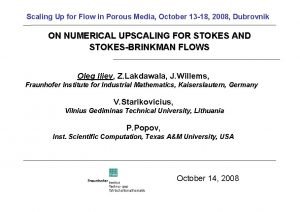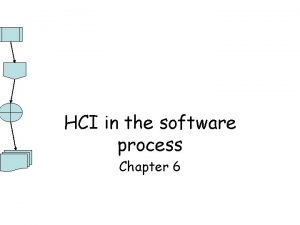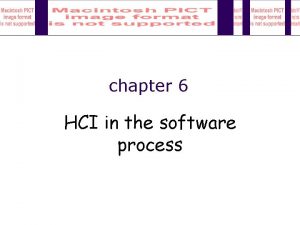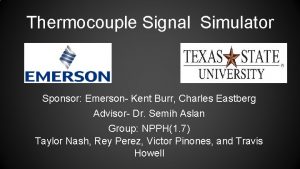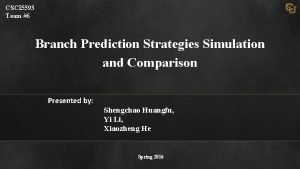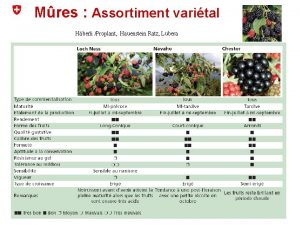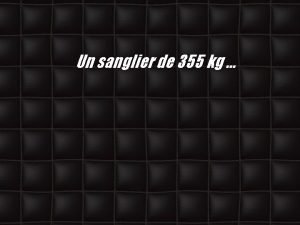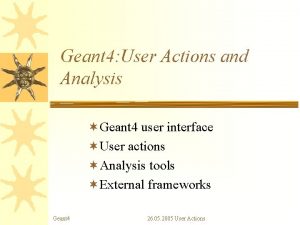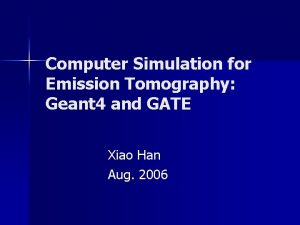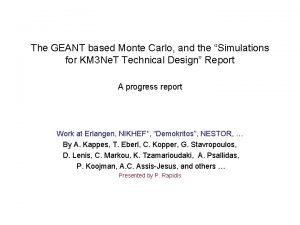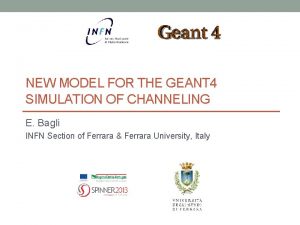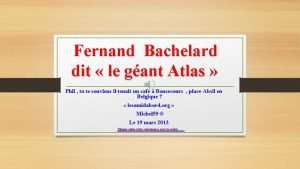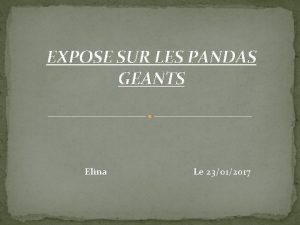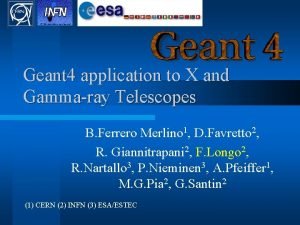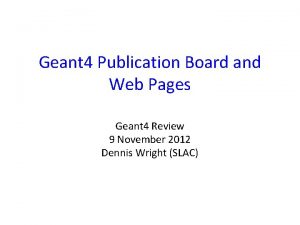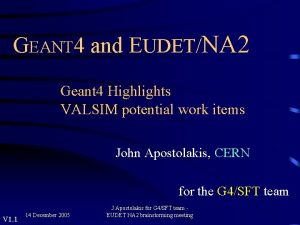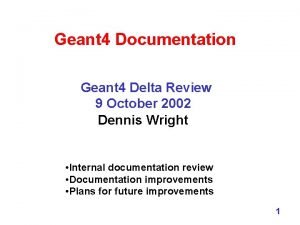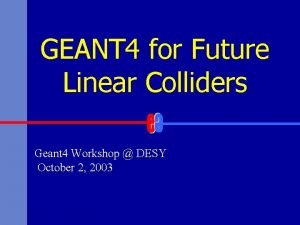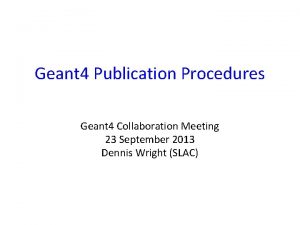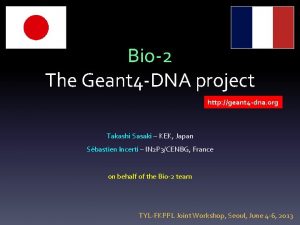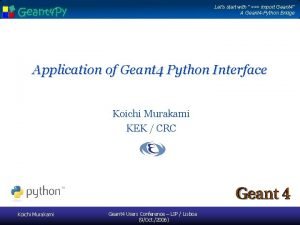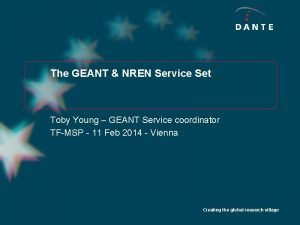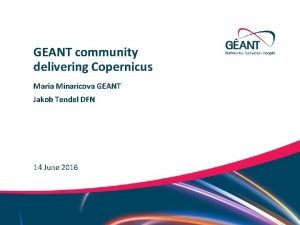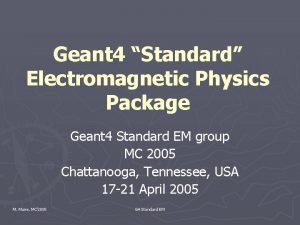Using Geant 4 and Opticksa to simulate liquid




















- Slides: 20

Using Geant 4 and Opticksa to simulate liquid Argon TPC’s Hans Wenzel, Krzysztof Genser , Soon Yung Jun, Alexei Strelchenko Fermilab HSF/WLCG workshop Nov. 19 -24 th 2020 a Author: Simon Blyth

Outline 2 Motivation: physics of liquid Argon TPC’s. Opticks/G 4 Opticks Prototype example: G 4 Opticks. Test Performance Summary and Plans 9/9/2021 Hans Wenzel HSF/WLCG workshop, Nov. 19 -24 th 2020

Single-phase liquid Argon TPC (l. Ar. TPC) The image below shows a display of the ionization signal: time + stereo wires or pixels allows for 3 D reconstruction d. Edx for PID track length for energy/momentum …. See: Dorota Stefan(CERN/NCBJ (Warsaw PL)), https: //indico. cern. ch/event/575069/contributions/2326563/attachments/1363382/2064171/LAr. Prinicipals. pdf 3 9/9/2021 Hans Wenzel HSF/WLCG workshop, Nov. 19 -24 th 2020

Scintillation/Ionization properties in liquid Argon 1 Rayleigh scattering length ~ 50 -60 cm. Complex Scintillation process through Ionization Argon can’t be excited by its own scintillation light where minimum ionization is 2. 105 Me. V/cm VUV wavelength shifting required for detection Absorption length ~ tenth of meters depending on purity Presence of electric field allows for separation of ions and electrons created in Ionization process: • Electrons drift to read out plane and produce signal. • Slow moving Ions might contribute to space charge effects. • Ionization and scintillation light are ‘anti’- correlated in a complicated way. • Photons are generated and traced by Opticks. Detection requires wavelength shifting from VUV to visible light. Photons hitting a Photodetector are returned as Photon Hits. • Electrons are collected in Hit collection and then traced by separate module. 1)Adapted 4 from Ben Jones: https: //microboone-exp. fnal. gov/public/talks/LAr. TPCWorkshop. Scint. Light_bjpjone_2014. pdf 9/9/2021 Hans Wenzel HSF/WLCG workshop, Nov. 19 -24 th 2020

Motivation • Using Geant 4 to simulate photon propagation on the CPU takes ~ hours to simulate 1 event for a typical liquid Argon TPC. Currently l. Ar. TPC experiments use Look Up Tables (LUT) or parameterizations for photon response. But: • only approximation, information not complete, • LUT grow with detector size to a point that jobs can’t run on a typical grid node, • still need full simulation to create the tables to run on traditional grids. Simon Blyth showed that Opticks speeds up the photon simulation to the level where it is comparable to the rest of the simulation: • Allows to run full optical simulation event by event. • Allows to investigate various ideas for improvements like: • Improve calorimetric energy resolution, • Using ratios like fast/slow scintillation light or light/ionization for Particle ID, • …. Not only Argon TPCs but also many experiments can benefit e. g. dark matter searches, dual readout calorimeters (e. g. Crystals: effect of Cerenkov light directionality, different TPC configurations …), various groups are investigating Opticks we aim to develop a flexible framework where detector geometry/configuration, physics list, output etc. are determined at runtime and don’t require recompilation. (like artg 4 tk/larsoft see: https: //cdcvs. fnal. gov/redmine/projects/artg 4 tk/wiki/Artg 4 tk). • • • 5 9/9/2021 Hans Wenzel HSF/WLCG workshop, Nov. 19 -24 th 2020

Opticks https: //simoncblyth. bitbucket. io/env/presentation/opticks_may 2020_hsf. html 1 EPJ Web of Conferences 214, 02027 (2019) https: //doi. org/10. 1051/epjconf/201921402027 Opticks : GPU Optical Photon Simulation for Particle Physics using NVIDIA® Opti. X TM Simon Blyth 1)Figure from Simon’s presentation 6 9/9/2021 Hans Wenzel HSF/WLCG workshop, Nov. 19 -24 th 2020

Opticks and NVIDIA® Only on: NVIDIA® hardware and software NVIDIA® CUDA NVIDIA® Opti. XTM Figure from Simon’s presentation 7 9/9/2021 Hans Wenzel HSF/WLCG workshop, Nov. 19 -24 th 2020

Opticks Open source: https: //bitbucket. org/simoncblyth/opticks/ Figure from Simon’s presentation Need: wave-length shifting(WLS) process on GPU (CUDA) similar to reemission! 8 9/9/2021 Hans Wenzel HSF/WLCG workshop, Nov. 19 -24 th 2020

G 4 Opticks hybrid workflow Figure from Simon’s presentation Discrete geometry 10 shapes Plans with respect to evolving G 4 Opticks/Opticks: • Use the same implementation of the scintillation process on CPU and GPU, use the same optical properties. • Implement WLS. • Currently G 4 Opticks is invoked at Geant 4 End of Event. Achieve true concurrency by using G 4 Tasking by J. Madsen. (available in next Geant 4 release: 10. 7) 9 9/9/2021 Hans Wenzel HSF/WLCG workshop, Nov. 19 -24 th 2020

G 4 Opticks. Test: • Geant 4 Application demonstrating the use of the G 4 Opticks hybrid workflow, • we plan to make it a Geant 4 advanced example • code available at https: //github. com/hanswenzel/G 4 Opticks. Test Features are: • Uses Geant 4 to harvest Scintillation and Cerenkov Gensteps 1. The harvesting is moved to sensitive Detectors/User. Stepping. Action. • Uses Opticks to generate and propagate optical photons, returns Photon-detector Hits. • Uses gdml with extensions for flexible Detector construction and to provide optical properties. The gdml extensions include: • Assigning sensitive detectors to logical Volumes. A library of various sensitive detector types is provided (specifically l. Ar. TPCSD, but also detectors for TOF, Muon detectors etc. ). • Assigning step-limits to logical Volume to match Geant 4 steps and TPC readout pitch. • Assigning visualization properties. • Assigning homogenous electric field. Make use of formulae, variables, loops, predefined NIST materials compact, human readable gdml. • Uses G 4 Phys. List. Factory. Alt (R. Hatcher) to define and configure physics: e. g. G 4 Phys. List. Registry: : Get. Modular. Physics. List <FTFP_BERT+OPTICAL+STEPLIMIT+NEUTRONLIMIT> 1)See backup slides • Uses Root IO to provide persistency. 10 9/9/2021 Hans Wenzel HSF/WLCG workshop, Nov. 19 -24 th 2020

Geant 4 G 4 Opticks Simplified G 4 Opticks. Test workflow Event loop: Begin of Event: Step: l. Ar. TPCSD Process. Hits: collect electrons l. Ar. TPCHits collect gensteps (C/S) End of event: Gensteps (C/S) Gensteps gdml. mac l. Ar. TPCHits input output Photon. Hits Photon Hits Tree: Event 1: l. Ar. TPCHits. Photon. Hits …… Root file Event 2: l. Ar. TPCHits. Photon. Hits …… Event N: l. Ar. TPCHits. Photon. Hits …… 11 9/9/2021 Hans Wenzel HSF/WLCG workshop, Nov. 19 -24 th 2020 Generate and propagate Cerenkov and Scintillation photons

Performance: very preliminary! CPU Intel(R) Core i 7 -9700 K 3. 6 GHz GPU Ge. Force RTX 2070" CUDA Driver Version /11. 0 CUDA Capability: 7. 5 VRAM: 7981 Mbytes Cores: 2304 Simple Geometry: Liquid Argon: 1 m 3 5 photo detectors (red) photon yield varied from 100 -50000 Photons/Me. V single 1 Ge. V muon Compare to ~ hour/evt using Geant 4 on CPU, RTX -> 2 x 12 9/9/2021 Hans Wenzel HSF/WLCG workshop, Nov. 19 -24 th 2020

Summary and Plans Summary: We made Simon Blyth’s Opticks work with Geant 4 10. 6. p 03. A prototype application: G 4 Opticks. Test is available and we plan to make it an advanced Geant 4 example. Various geometries are available as gdml. Preliminary benchmarking looks very promising. • • • Plans: • • • Implement current Geant 4 Scintillation process on GPU. Implement wavelength shifting process on GPU. Develop Geant 4 Task application with Opticks where: • Gensteps chunks are collected in-situ during the tracking/stepping loop, once a predetermined chunk size is reached the optical photon propagation is offloaded to the GPU (device), while the rest of simulation and gensteps collection continues on the CPU (host). special thanks to Simon Blyth!! 13 9/9/2021 Hans Wenzel HSF/WLCG workshop, Nov. 19 -24 th 2020

Backup Slides

15 9/9/2021 Hans Wenzel HSF/WLCG workshop, Nov. 19 -24 th 2020

Gensteps (Scintillation and Cerenkov) A Genstep collects all Scintillation Genstep: information necessary to generate Scintillation and Cerenkov photons on the GPU. In order to simplify G 4 Opticks code and to decrease the need for future maintenance, we modified Geant 4 10. 7 to include small changes to the G 4 Cerenkov API to retrieve all needed information to generate and propagate Cerenkov photons with Opticks. No changes were necessary for Scintillation photons. 16 9/9/2021 Hans Wenzel HSF/WLCG workshop, Nov. 19 -24 th 2020

Visualization of Daya Bay Detector


Figure from Simon’s presentation

 Fluke 789 simulate
Fluke 789 simulate Simulate oled upscaling
Simulate oled upscaling It simulate or animate some features of intended system.
It simulate or animate some features of intended system. Hci chapter 6
Hci chapter 6 Ads1675
Ads1675 Simulate
Simulate Theories of breakdown in liquid dielectrics
Theories of breakdown in liquid dielectrics Lever arm rule liquid-liquid extraction
Lever arm rule liquid-liquid extraction Myrtillier géant
Myrtillier géant Renmap
Renmap Sanglier turquie
Sanglier turquie Le plus grand godet du monde
Le plus grand godet du monde Action geant
Action geant Geant computer
Geant computer Geant simulation
Geant simulation Geant 4
Geant 4 Le géant atlas dans son café de bonsecours
Le géant atlas dans son café de bonsecours Exposé panda géant
Exposé panda géant Geant 4
Geant 4 Geant 4
Geant 4 Pub geant
Pub geant

